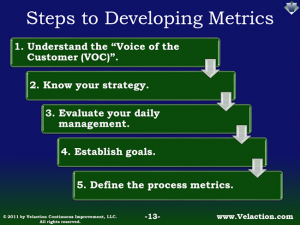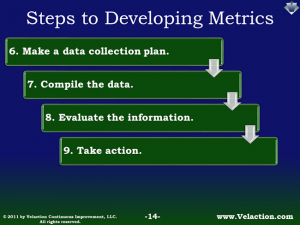9 Steps to Better Metrics (+Video)
As I talk about making improvements, I invariably end up telling people they need focus more on their processes. Time and time again, just the simple act of gaining a deeper understanding of how work is done will shed light on what to improve. The spotlight shines even brighter when one crosses functional boundaries and looks at upstream and downstream operations.
But after that initial knowledge is gained, I often tell people that they should develop metrics to see if the process is delivering the results they want. And of course, the follow-up question is “How?”
So, I recently put together a class on how to use metrics to more effectively lead an organization. It is titled Managing With Metrics and is part of the Velaction Training System.
(NOTE: Tim McMahon of ALeanJourtney.com and I hosted a 55-minute webinar of an excerpt of this class. You can view it here.)
One of the challenges of making a class out of an excerpt of a bigger class is that you have to choose what to leave out. Unfortunately, to make the webinar fit into the time we had available, I had to chop out the basic framework of the class—the 9-step process for putting together metrics that work. I’ve been doing these steps for years, but finally put them in writing. Here they are…
- Understand the “Voice of the Customer (VOC)”. Most people use external customer needs to develop metrics, but neglect to do the same for internal customers. Make sure you are asking both groups what they want. For the internal customers, try using “either/or” types of questions to really dial in on what is important to them.
- Know your strategy. Sometimes your strategy will go beyond what your customers know to ask for. Steve Jobs was a master at looking at future customer needs and putting that into Apple’s strategy. The company’s strategy will also help you understand which customer needs to focus on most.
- Evaluate your daily management. How you run your operation can shed light on what you want to measure. Often this includes measuring backlog, demand, capacity, and daily production performance. It can also provide a good opportunity to track obstacles.
- Establish goals. What your customer wants is independent of your process. Don’t decide what they want based on what you can do. Determine what you have to do based upon what your customers need. Of note, goals often turn into results-oriented metrics.
- Define the process metrics. Once you know how you will measure the output of a process, look at the actual nuts and bolts of the steps within the operation. If you pick the right process metrics, you can predict the output of the process.
- Make a data collection plan. Data collection is a process, and has to be defined. If it is not done consistently, your metrics will have far less value as a management tool.
- Compile the data. Collecting data is only the first step. It must be plugged and chugged into something useful.
- Evaluate the information. When the data is compiled, you need to look at it to interpret the meaning. The more structured this approach is, the better.
- Take action. Without this step, there is no point in tracking metrics at all. In fact, if there is no action based on problems identified by metrics, it is worse than not collecting data at all. It consumes resources and generates false hope for team members, both of which destroy job satisfaction.
As always, I love hearing feedback from you, and often change some of my content based on your collective wisdom. What do you think of these steps? Anything you would add or remove?
(Remember, you can get the full Managing With Metrics PowerPoint presentation here.)





2 Comments
Ann M. · October 21, 2011 at 5:56 am
Thanks for the interesting info on metrics. We will be reviewing our dept. lean boards very soon and trying to update them to reflect what metrics we need and what we don’t need. This post will definitely be referred back to then.
Jeff Hajek · October 21, 2011 at 12:01 pm
Ann,
Thanks for the feedback. I’m hoping to get this on DVD before too long, so there may even be some better information available when you start updating your metrics.
Good luck!
Jeff